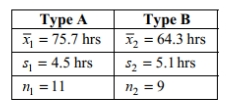Construct the indicated confidence interval for the difference between the two population means. Assume that the two samples are independent simple random samples selected from normally distributed populations. Do not assume that the population standard deviations are equal. A paint manufacturer wished to compare the drying times of two different types of paint. Independent simple random samples of 11 cans of type A and 9 cans of type B were selected and applied to similar surfaces. The drying times, in hours, were recorded. The summary statistics are as follows.
Construct a 98% confidence interval for the difference between the mean drying time for paint of type A and the mean drying time for paint of type B.
Definitions:
Quick Ratio
A financial metric that measures a company's ability to cover its short-term liabilities with its most liquid assets, excluding inventory.
Current Liabilities
Short-term financial obligations due within one year or within the entity's operating cycle if longer.
Debt-Paying Ability
An indication of a company's financial strength, referring to its capacity to meet its debt obligations as they come due.
Solvency
The ability of a company or individual to meet long-term financial obligations, indicating financial health.
Q2: Use the data in the given table
Q3: The textbook defines significantly low or high
Q5: For a recent year, the following are
Q19: On a test, 74% of the questions
Q26: Define statistically stable (or "within statistical control").
Q28: Carbon monoxide is measured in one city
Q29: When testing the claim that
Q32: To test the null hypothesis that
Q42: The data below represent the weight
Q101: In a card game, it is possible